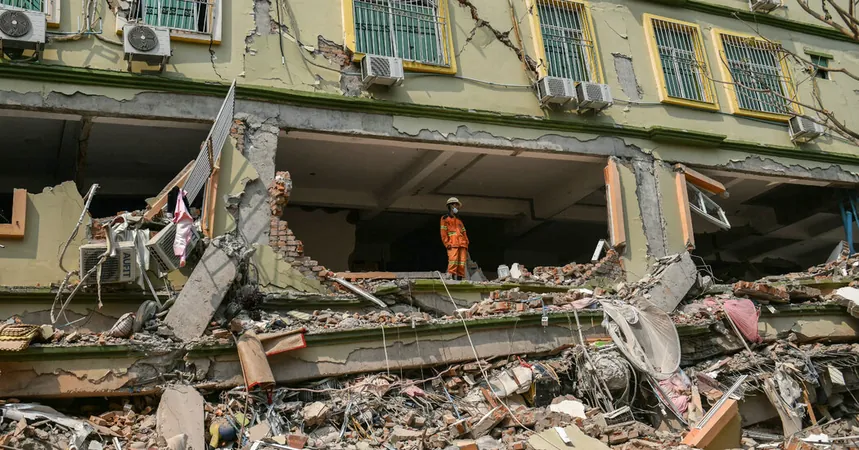
Myanmar Earthquake Devastation: Over 1,600 Lives Lost in Catastrophic Quake Followed by Ongoing Civil Unrest
2025-03-30
Author: Wei
The recent earthquake that struck central Myanmar has left a catastrophic toll of over 1,600 people dead, according to reports from the country's military leaders on Saturday. This tragic event unfolded in a nation already grappling with civil unrest, igniting a race against time for rescue workers as they frantically search for survivors amidst the rubble.
The earthquake, which occurred on Friday in the vicinity of Mandalay—Myanmar's second-largest city—has wreaked havoc on residential areas, placing immense pressure on emergency services. Volunteers like Thaw Zin report that hundreds may still be trapped under the debris of collapsed buildings, including apartments, religious sites, and other structures. "We are trying our best with what we have," Zin stated, reflecting the challenging circumstances facing rescuers.
This natural disaster has further exacerbated the instability of Myanmar’s military government, which has struggled to maintain control amid a brutal civil war. Before the earthquake, nearly 20 million of Myanmar's approximately 54 million population were already suffering from food insecurity and inadequate shelter, according to United Nations officials.
In a shocking and controversial move, military jets conducted airstrikes on a rebel-held village in northern Shan State, even as rescue operations were underway. "I just can’t believe they did airstrikes at the same time as the earthquake," lamented local resident Lway Yal Oo. This has led to an increase in public anger towards the military leadership, especially as many citizens feel abandoned in their time of need. "We don't need guns, we need helping hands and kind hearts," emphasized volunteer worker Thaw Zin.
In recognition of the disaster’s scale, the junta has declared a state of emergency across six regions, including areas controlled by anti-military factions. However, communication remains a significant barrier, particularly in regions where internet access is severely limited.
Amidst the chaos, a rare appeal for assistance was made by the military government, which has been under international sanctions and largely isolated for its human rights abuses. In response, China has flown in dozens of rescue workers and pledged nearly $14 million in aid, including crucial supplies like tents and first aid kits. South Korea has committed $2 million in aid through humanitarian channels, while Malaysia is sending teams to assist with relief efforts.
However, the world’s wealthiest nations still face uncertainty regarding their response, especially given their prior sanctions on the junta. Delays in aid delivery due to damaged infrastructure and military control complicate matters further; essential supplies reaching Yangon still need to be transported over vast distances to reach affected areas like Mandalay.
In the immediate aftermath of the quake, those in nearby cities are mobilizing to bring food and fuel to the disaster zones. Streets in Mandalay are choked with ambulances, as hospitals struggle to accommodate the influx of casualties. In the face of shattered hopes, survivors like Ko Thien Win voice the grim reality: "Yesterday we found some survivors, but today the chances are much lower."
The personal toll is tragic and profound. Many individuals are stranded in hospitals, grappling with injuries while anxiously awaiting news of their loved ones. Tay Zar Lin, who suffered a broken leg during the quake, shared his pain, revealing that his wife is still trapped in the tailor shop where she worked. "I pray that yesterday morning wasn’t the last time I saw her," he expressed in despair.
Meanwhile, the international diaspora of Myanmar is left waiting anxiously for updates about friends and relatives affected by the calamity. Richard Nee, a former resident now living in Taiwan, described the heartbreak of sporadic communication. "We are at the mercy of the situation," he said.
Experts suggest that many structures in Myanmar, located on a fault line known for seismic activity, were inadequately prepared for an earthquake of this magnitude. "Many buildings could withstand a magnitude 6 quake, but this one had far greater intensity," warned a concerned engineer.
Tragedy strikes deeply as survivors share their harrowing experiences, including Su Wai Lin, who narrowly escaped with her life. Despite her quick thinking, her husband tragically lost his as he attempted to save a neighbor before the building collapsed. "My child will be born without a father," she wept at a hospital, embodying the profound sorrow that reverberates through the nation in the aftermath of this disaster.
As Myanmar continues to grapple with the fallout from this catastrophic event, the world watches, hoping for resilience and recovery amidst the devastation.

 Brasil (PT)
Brasil (PT)
 Canada (EN)
Canada (EN)
 Chile (ES)
Chile (ES)
 Česko (CS)
Česko (CS)
 대한민국 (KO)
대한민국 (KO)
 España (ES)
España (ES)
 France (FR)
France (FR)
 Hong Kong (EN)
Hong Kong (EN)
 Italia (IT)
Italia (IT)
 日本 (JA)
日本 (JA)
 Magyarország (HU)
Magyarország (HU)
 Norge (NO)
Norge (NO)
 Polska (PL)
Polska (PL)
 Schweiz (DE)
Schweiz (DE)
 Singapore (EN)
Singapore (EN)
 Sverige (SV)
Sverige (SV)
 Suomi (FI)
Suomi (FI)
 Türkiye (TR)
Türkiye (TR)
 الإمارات العربية المتحدة (AR)
الإمارات العربية المتحدة (AR)